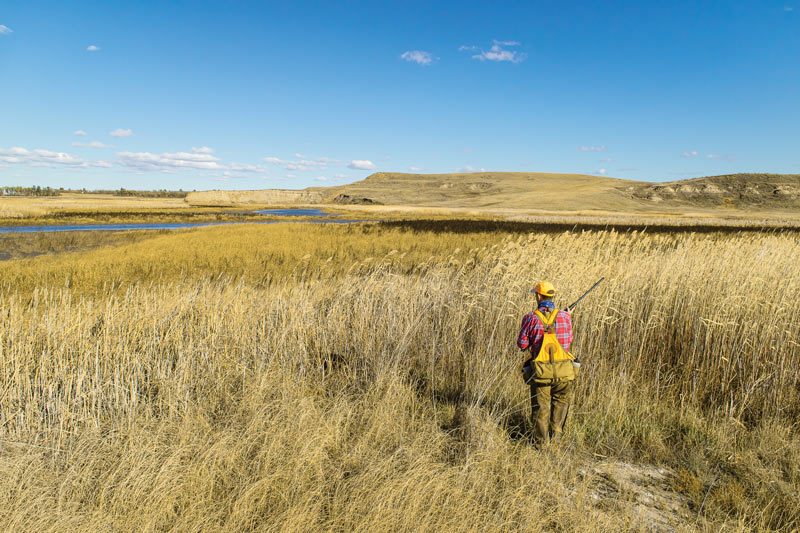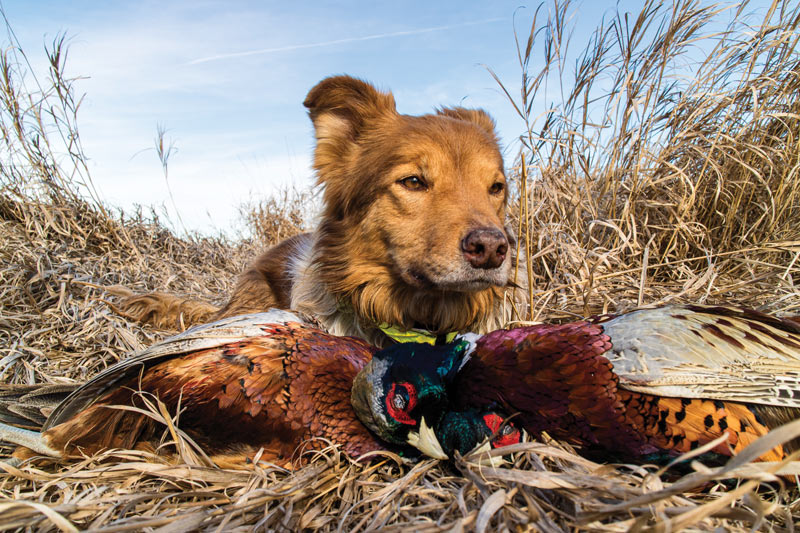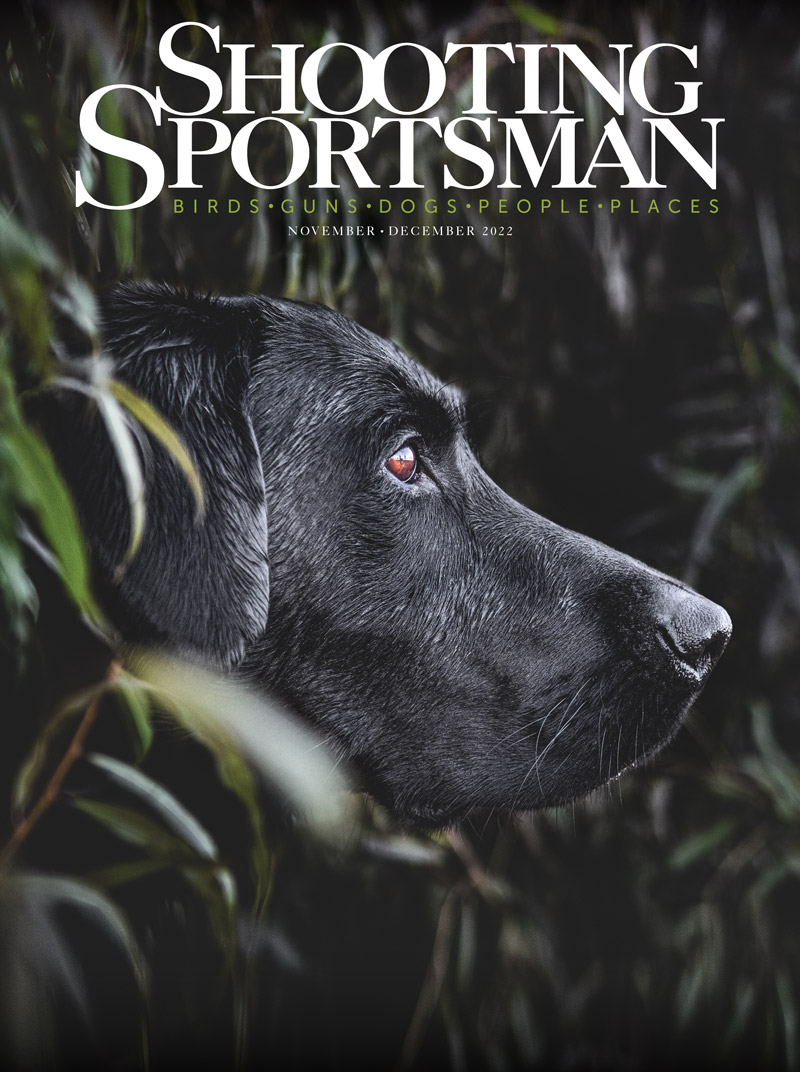My legs burned. Frustration festered, flourished really. Don’t get me wrong: There was no other place I wanted to be and nothing else I wanted to be doing. November winds animated the small sea of dead grasses and legumes around me while wicking away some of the sweat seeping from my pores. Both my heart rate and determination were high as I pounded forward behind a hard-charging dog, hoping that the half-mile race would result in roosters flushed in range.
Mid-season pheasant hunting can be like that, and sometimes I feel like simply running down the birds in full athletic glory because I still can. There are days it works too. But pressured pheasants are the Zen masters of hunter avoidance. With one bird in hand, I petted my little Border collie, Katie, as we both took a rest, allowing a cooling wind to do what was needed. I had worked up to a good boil and Katie’s panting indicated the she had done the same.
I studied the gently rolling hills, isolated tree rows and marshy shoreline around me. I felt vibrant, alive—enthralled with one of life’s greater moments. My fascination remained childlike. So did my willingness to run around like a child. I’m a firm believer that taking joy in simple pleasures and one’s surroundings keeps a body youthful. So far the plan is treating me well enough.

Speaking of plans, however, I needed a new one for these pheasants. I debated whether to pursue the birds that had settled into the marsh or double back and let Katie work the individuals that had slipped away as we’d passed. Both were solid options for the pressured birds. The pheasants in the cattails would still be in groups and prone to “the fuse is lit” chain-reaction exodus I had just witnessed. Going after scattered singles would preclude that problem. Decisions, decisions. At least in the cattails I could count on the occasional rooster hunkering down at the cover’s edge—a welcome byproduct of sheer numbers and confusion. Then again, conventional approaches weren’t panning out very well . . . .
At that time my favorite little part of North Dakota was overflowing with pheasants—something that is no longer the case. But the wave lasted for a number of years. Once the good news went public, legions of hunters arrived and sharp-spurred roosters quickly earned PHDs in survival tactics. When the birds got smarter, I figured I had to also. That day I tried something new. Some new tactics play out well while others get discarded from the playbook, never to be attempted again.
We ventured to the lakeshore where many pheasants had fled our assault. Heavily worn deer and hunter trails had turned the marsh into a pheasant Autobahn. I needed a blocker but had none. Then again, maybe I did . . .
That fateful day in North Dakota something wonderful happened. I discovered that it was indeed possible for a poor chap like me to enjoy a driven pheasant shoot without needing airline tickets, beaters or a loader. All it took was a Border collie, a gun and a crazy idea.
As we entered the marsh a small contingent of nervous birds jumped wild. Pheasants have good ears, so I figured that the rest were now off to the races. With Katie in hot pursuit, the stage for a grand experiment was set; so I quietly slipped out onto the barren stripe between the cattails and the water’s edge and did my best imitation of an Olympic sprinter until reaching a prominent notch in the shoreline. That blocker I needed? I was it. I took up a strategic position and waited in complete stealth mode.

Soon my ears picked up a frenzied rustling amongst the dry stalks. Not far behind, Katie’s collar tags chimed their tinkling prelude, which was growing louder by the moment. The crescendo built until a hen shot upward. Then a rooster burst out. The fuse had been lit, and the bomb was about to explode. At my first shot, pheasants blew out of the cattails in mass confusion. It was a total and complete surprise!
A single bird is fairly simple to pick out against an empty sky; isolating one amongst a large group requires concentration. I was running the risk of completely unraveling in the heat of the action. Scientists refer to it as “predator confusion.” I call it good old-fashioned panic. Let’s just say that things sorted themselves out before all the birds escaped. The flurry of cackling and roaring wings is forever etched in my memory.
The tactic I used that day is no doubt meant for a well-trained flushing dog, be it a retriever, spaniel or even a herding dog like Katie or my current Border collie, Rusty. Yes, Rusty, too, has pulled this duty for me. A solid tactic is always a valuable arrow to keep in one’s quiver.
Rusty’s first go at this technique was during his first season of working wild roosters. While talking with a landowner who had long been kind to me, I was told by his son that there were birds near a creek bottom I hadn’t hunted in years. He said that he had planted the spot differently that season. Shaun likes to hunt pheasants, too, and what I discovered made me smile. A strip of standing corn was bordered on the east side by a bare pasture. West of the strip, CRP provided a nice place for birds to hang out when they weren’t stuffing themselves with corn. Most important, however, was that Shaun had mowed a path between the CRP and the corn. At the far end was more open ground separating the corn from a creek bottom.
Now then, how should a lone hunter approach this? If boosted from the corn, birds surely would head for the cover of the creek bottom or the CRP, so it seemed prudent to ignore the bald pasture to the east. If I pushed the corn directly, the birds would simply run ahead and flush out the end—their cackling laughter mocking my inability to be everywhere at once. I needed them to break for the CRP without knowing my position, so I could get clear shots at good range. A modified version of the one-man driven shoot seemed worth trying.
Once again, the scenario hinged on total surprise. Arriving shortly after feeding time the following morning, I parked far enough away to not disturb any occupants of the corn. I also knew that the last thing I needed to do was spook a deer and send it through the corn like a cruise missile.
This time I had no intention of blocking for Rusty—at least not until we reached the end of the corn. For the plan to pan out, I needed to be able to track his movements when I could not see him. It meant using my ears, which would be difficult with the noisy rattle of wind-agitated cornstalks. A bell would solve that.
I hung a bell on Rusty’s collar and sent him in. Listening to the frenetic tinkling of the bell, I paralleled his progress along the corn’s edge, staying slightly ahead of him along the anticipated flight path of escaping birds. Almost as soon as we started all hell broke loose. We’d caught them completely off guard! As predicted, flushing pheasants exited for the CRP. Once I shot, however, a few wiser birds bent for the creek bottom cover. But by then it was already too late for three of their friends. My only regret? The entire hunt spanned only three minutes . . . .
As well as this ploy serves me; it would become passé if I relied on it repeatedly. In addition to traditional “park and walk” endeavors, other maneuvers play important roles in my pheasant hunts. One is to hunt where other hunters don’t bother to follow rousted roosters. Another is a reverse approach. Both tactics can be useful even at the same location.
Sometimes hunters stack the odds against themselves by being predictable. Watch a popular hunting area for any length of time, and two things typically become evident: Hunters regularly make the same approaches to an area, and pheasants often develop programmed responses to those approaches.
One of my favorite hunts involves working a small public-land food plot that has a creek bottom at one end. Before heading to the plot, however, I frequently search a nearby butte for sharp-tailed grouse. One day as Rusty and I were hunting the butte, two trucks rolled slowly past on the two-track below. At the point where the road passes closest to the food plot, the trucks pulled off and the hunters got out, uncased their shotguns and released a pair of dogs. During busier seasons, several times a day hunters park at the same spot to approach that plot.


Sometimes uncoventional strategies pay off when hunting experienced wild roosters.
Predictably, at the first sign of danger pressured birds took flight and headed across the streambed. The hunters had facilitated their escape by being predictable themselves. A few birds did make mistakes and find their way into game bags, and this reinforced the idea that the hunters’ technique for working the plot was still decent. The bulk of the birds, however, easily escaped to the far side of the creek. When the merry band of hunters returned to their truck and moved on, I turned my attention back to grouse.
An hour later I crossed the creek at a muskrat dam a quarter-mile upstream from where the pheasants had flown and cut Rusty loose. Knowing that most times hunters don’t bother crossing the creek, I had employed this tactic in the past and found that birds held better once they’d settled in and filtered into adjacent cattail-filled oxbows.
Plenty of pheasants remained near where they’d landed, but they weren’t naive and quickly evacuated. Once they split up, however, they became easier to approach, and Rusty and I enjoyed going one-on-one with a number of crafty roosters. What followed was a glorious hunt, and soon my third and final bird bounced in the tall grass along the marsh edge.
Reversing one’s approach is another good way to deal with pheasants that pull dirty tricks. Hunters may be predictable, but so are the conditioned responses of birds that allow themselves to slip into routines. I’ve driven beyond the aforementioned food plot, and then hiked into the creek bottom while hidden below the high banks with Rusty at heel. I know that when I scale the steep bank and send Rusty into the plot at the birds’ normal escape point, the pheasants are going to get discombobulated. And they do—typically blowing right past me in their well-rehearsed routine, just as they did the first time I tried the maneuver. I’ll say this much: It sure feels good to “get one up on ’em” when they think they’ve got you beat.
A lot of things have happened since I shot my first ringneck more than 30 years ago. I’ve thwarted them and been thwarted by them in many states, including my home state of Wyoming. Local variations in habits and habitat abound, yet the adaptable pheasant still has tendencies that help adaptable hunters stay ahead of the game. And the more options I have in my bag of tricks, the more enjoyable my time afield is.
Garhart Stephenson makes a life of wandering with rod and gun both near his home, in Lander, Wyoming, and far away. With his dog, Rusty, at his side, he is always eager to see where adventure leads.





